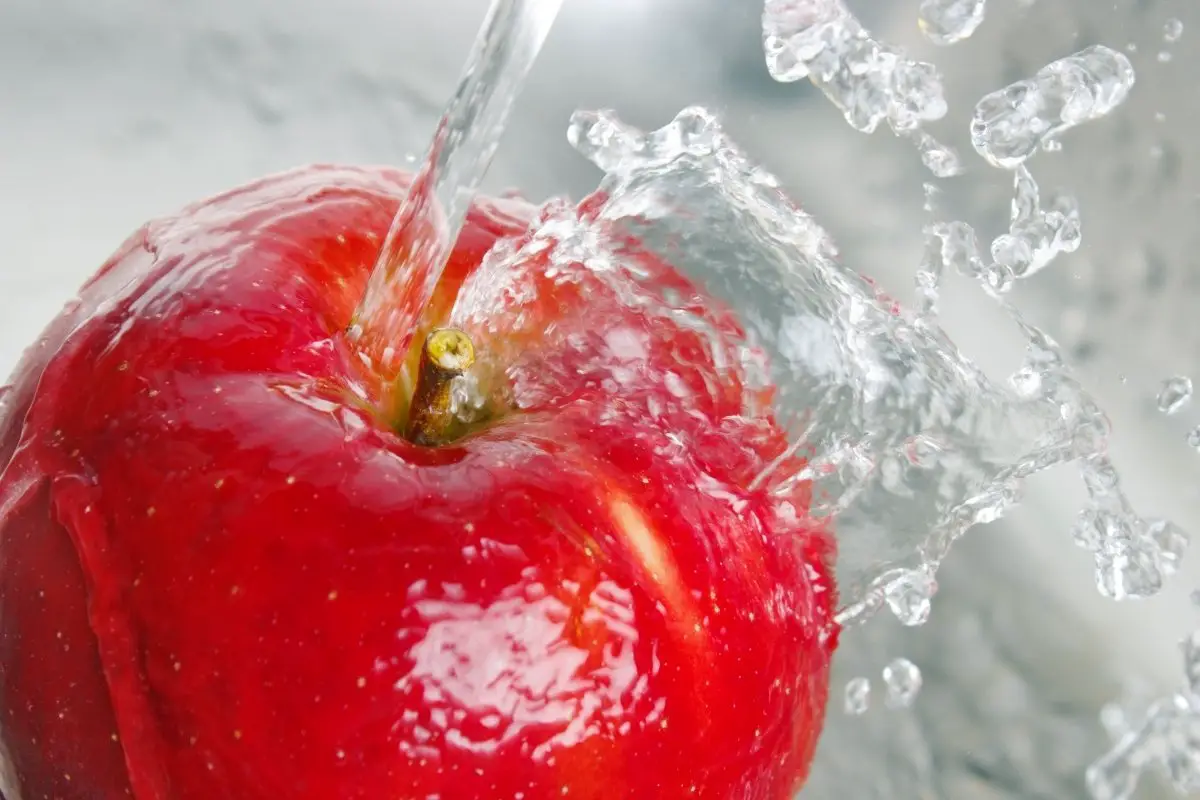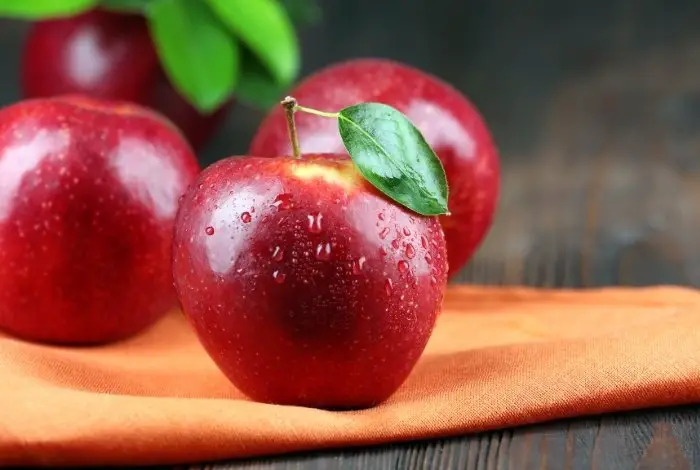Last Updated on February 3, 2023
Are you looking to make candy apples for Halloween or a party? Knowing how to remove wax from apples for candy apples can help solve this problem.
Wax is typically put on apples to help keep them fresh. You always want to wash off the wax, as it can cause air bubbles to form on the candy coating. If left on, it leads to an undesirable look, as they won’t have a smooth finish.
Oftentimes, just rinsing your apple under running tap water isn’t enough to fully remove the wax. Fortunately, with just a basic pantry staple and some boiling water, you can thoroughly clean your apples. This gives them a clean finish that is perfect for dipping in candy.
What You Will Need to Follow this Tutorial
For how to remove wax from apples for candy apples, you will need:
- Apples
- A large pot of boiling water
- 1-2 tablespoons baking soda or apple cider vinegar
- Large spoon
- Paper towels
- Baking tray
- Parchment paper
Bayou Classic 1144 1144-44-qt Stainless Stockpot with Basket
Steps by Step Instructions: How to Remove Wax From Apples
Step One: Boil Water and Add Baking Soda or Apple Cider Vinegar
Fill a large pot full of water and bring it to a boil. Add 1-2 tablespoons of baking soda or apple cider vinegar and mix. Both baking soda and apple cider vinegar work along with the hot water to rid the apples of the wax.
Step Two: Add Your Apples
Once the water is close to a boil or at a boil, add 3-4 apples into the pot at a time. Use a spoon to turn them around so they get fully coated in water. Leave the apples in the water for 30 seconds to one minute.
Step Three: Dry Apples
After the apples have been washed, thoroughly dry them off with some paper towels. Make sure you dry every nook and cranny, as any water on the apple can also cause bubbles to form on the apples.
Once dried, place the apples on a baking tray to allow them to air dry in case you miss any water. You can dip your apples in candy within the next 48 hours. After 48 hours, sticky sap residue may begin to form on the apple, which you will need to rewash when this happens.
Once they are ready, you can dip your apples in the candy melts. The clean apples will allow the candy to stick smoothly to the apples, with no air bubbles. Allow the apples to fully dry once dipped on parchment paper before serving them.
Tips and Tricks for How to Remove Wax from Apples
Knowing how to remove wax from apples is a key step in making candy apples. The best apples to use for candy apples are Granny Smith, as their tart flavor pairs well with the sweetness of the candy coating. Their firm texture is also ideal to hold the weight of the candy.
In addition, Fuji, Gala, Honey Crisp, and Pink Lady work great for candy apples. Be certain to use fresh, firm apples, ideally free of bruises or marks, for the best results. Not only will they taste better, but they will also look better as well.
Candy apples can be stored at room temperature for 2-3 days. They should be kept in an airtight container, in a cool, dry area away from the sunlight. Avoid keeping your candy apples in the fridge, as this can cause the candy coating to become sticky and messy.
When dipping the apples, carefully swirl the apples in the candy, tapping off any excess. To allow the candy to stick, make sure the candy is still warm when dipping. Placing the candy apples to dry on the baking sheet lined with parchment paper to allow them to dry without sticking.
The great thing about candy apples is you can make them in different colors. Though red is the traditional color used, you can also use pink, blue, orange, black, white, or whatever color you like. This is great for any themes you may have for the parties you host.
Read more about What to Do with Mushy Apples
Why Are Apples Waxed?
When you buy apples at the store, they come with a wax covering that works to preserve the apple and keep them fresh for longer. While the wax coating is not harmful, it is best to remove it before eating, especially if you are making candy apples. Removing the wax will allow the candy coating to stick better to your apple.
When apples are picked, they have a natural wax coating for protection. However, this natural coating is removed when the apples are washed to prepare them for being sold. Farmers will then put a fruit wax coating on the apples to keep moisture from escaping and make the apples more appealing.
Is the wax on apples bad for you?
The wax on apples is not bad for you as it is made from natural and food-grade ingredients. This makes it safe to eat as the wax is completely edible.
No more than two drops of wax are added to an apple when it is being prepared to sell and most of the time it is even less than two drops. In fact, just one pound of wax may cover as many as 160,000 apples.
The sources of wax for apples come from carnauba wax, candelilla wax, and sometimes a small amount of grade shellac, which is derived from a secretion of the lac bug. Carnauba wax comes from the leaves of a Brazilian palm and candelilla wax comes from reed plants.
Wax has been used on apples since the 1920s to keep the moisture in the apples. The Food and Drug Administration ensures that the wax is safe to eat.
While the wax is safe to eat, many people prefer to wash it off before eating. When it comes to making candy apples, it is best to remove the wax to allow the candy coating to stick better to your apple and have a smooth, glossy finish.
How Do You Get the Wax Off Apples Without Boiling Them?
There are a few different methods you can do to remove wax from apples besides boiling them. One option is to combine one tablespoon of lemon juice and one tablespoon of baking soda and mix until combined. Dip the apples in this mixture, being sure to thoroughly coat the apples.
Next, use a vegetable scrubber to scrub your apples. After thoroughly scrubbing your apples, rinse the lemon juice and baking soda mixture off with cool water. You can also use vinegar instead of lemon juice and follow the same steps to remove the wax.
You can also add two cups of water to your bowl and mix with one teaspoon of baking soda in a large bowl. Then, add your apples to the water and allow them to soak for 15 minutes, and then rinse them off.
Salt water also works to remove the wax from your apples. Add one gallon of water with one teaspoon of salt in a large bowl and then add your apples. Swirl your apples around in the saltwater mixture and then rinse them under cool water.
Depending on what you are making, you can also peel the skin off of your apple. Be sure to not wash your apple with soaps or cleaning products as this is not safe.
Does Vinegar Dissolve Wax?
Vinegar is another household item you can use to remove wax from apples. Not only will it dissolve the wax, but it will also kill bacteria and remove any pesticides.
You can use white vinegar to remove wax and clean your apples. Fill a large bowl with water and then add one cup of white vinegar and let your apples soak in the bowl for five to 10 minutes. Then scrub your apples and rinse them off with cool water.
You can also fill a bowl of hot water with two tablespoons of distilled vinegar and two tablespoons of baking soda. Allow the apples to sit in the mixture for five to 10 minutes before wiping them with a kitchen towel and then rinsing them under cold water.
Another option is to use apple cider vinegar. To do so, add apple cider vinegar to a paper towel and then thoroughly wipe the apple with the paper towel. After that, rinse your apples under cool water to remove the vinegar and wax.
Will Vegetable Oil Remove Wax?
Vegetable oil is typically not used to remove wax from apples. However, you can cover your apple in vegetable oil and scrub it with a vegetable scrubber. This method can work but there is no guarantee you will remove all of the wax from your apple.
If you do use vegetable oil on your apples to remove wax, be sure to thoroughly wash them off afterward under cool water. A better option than vegetable oil would be to use vinegar, such as white vinegar or apple cider vinegar.
Vinegar is effective for removing wax from your apples. In addition to removing wax, vinegar can also remove pesticides and bacteria from apples.
You can use a mixture of one tablespoon of vinegar and one tablespoon of baking soda to remove wax. Use a vegetable scrubber to scrub the mixture on your apples before rinsing them off under cool water.
You can also soak apples in a large bowl of water and vinegar. Fill a bowl with cold water and then add one to two cups of distilled white vinegar. Allow your apples to soak in the mixture for five to ten minutes.
Then, use a vegetable scrubber to scrub your apples after they have soaked. Next, wash your apples under cool water to remove the vinegar mixture.
Do Organic Apples Have Wax on Them?
According to the USDA National Organic Program rules, organic fruit is allowed to have wax as long as it is using non-synthetic, food-grade substances which include Carnauba wax. While organic apples can have wax that adheres to the USDA rules, not all companies that sell organic apples will use wax.
Some companies will sell organic apples with their natural wax still on. Others will wash the natural wax off and use USDA-approved wax.
The natural wax on apples is known as bloom. It helps the apple retain moisture and helps prevent it from decay. The natural wax on apples can have a white appearance and be heavy and greasy. Though it is safe, many people prefer to wash or wipe it off.
Smooth and Wax-Free Candy Apples: How to Remove Wax From Apples
Removing the wax from apples is a key step when making candy apples. By simply placing the apples in hot water with baking soda or apple cider vinegar, you can remove the wax from the apples. The apples will then be smooth and allow the candy to stick to them free of any bubbles.
No matter what time of the year it is, candy apples can make a wonderful treat. They are simple to make and people of all ages love them.
Did you enjoy this post on how to remove wax from apples for candy apples? If so, please share this tutorial with your friends and family.

Ever since she was a young girl, Anna has been a lover of desserts. As an adult, she enjoys
baking a variety of desserts from cakes, cookies, brownies, bread, and more from scratch. She
enjoys sharing her passion for baking with others who also have a sweet tooth. From properly
measuring ingredients to making sure they are the correct temperature, Anna knows the
importance small details can make in baking. She wants to share her experience with others in
hopes they can make the most delicious baked goods. When she’s not busy blogging, Anna
enjoys trying new recipes in the kitchen.



